Using Environmental Simulations to Test the Release of Hazardous Substances from Polymer-Based Products: Are Realism and Pragmatism Mutually Exclusive Objectives?
Abstract
:1. Introduction
2. Aging Exposure Types
2.1. Weathering
2.2. UV Radiation in Terms of Photocatalysis or Photocatalytic Effects
2.3. Ozone as an Example of a Corrosive Gas
2.4. Soil Bed
3. Mass-Transfer Processes
4. Tailoring Exposure Tests—Examples
4.1. Metals and PAH from Synthetic Sports Surfaces
4.2. Antioxidants from PE
4.3. Flame Retardants from Thermoplastics
4.4. Carbon Nanotubes from Polymer Nanocomposites
4.5. Additives from Polymer Recyclates
5. Comparison of Natural and Artificial Exposure Tests
5.1. Real Weathering Versus the Weathering Chamber and Soil Bed Test in the Example of the Release of Brominated Flame Retardants
5.2. Release of Biocides from Coatings
5.3. The Time Scale Conundrum
5.4. Long-Term Validation
6. Conclusions
Author Contributions
Funding
Conflicts of Interest
References
- Koch, C.; Sures, B. Degradation of brominated polymeric flame retardants and effects of generated decomposition products. Chemosphere 2019, 227, 329–333. [Google Scholar] [CrossRef] [PubMed]
- Rosato, A.; Barone, M.; Negroni, A.; Brigidi, P.; Fava, F.; Xu, P.; Candela, M.; Zanaroli, G. Microbial colonization of different microplastic types and biotransformation of sorbed PCBs by a marine anaerobic bacterial community. Sci. Total Environ. 2020, 705, 135790. [Google Scholar] [CrossRef] [PubMed]
- Urbanczyk, M.M.; Bester, K.; Borho, N.; Schoknecht, U.; Bollmann, U.E. Influence of pigments on phototransformation of biocides in paints. J. Hazard. Mater. 2019, 364, 125–133. [Google Scholar] [CrossRef] [PubMed]
- Drewes, J.E.; Hemming, J.; Ladenburger, S.J.; Schauer, J.; Sonzogni, W. An assessment of endocrine disrupting activity changes during wastewater treatment through the use of bioassays and chemical measurements. Water Environ. Res. 2005, 77, 12–23. [Google Scholar] [CrossRef]
- Koch, C.; Schmidt-Kotters, T.; Rupp, R.; Sures, B. Review of hexabromocyclododecane (HBCD) with a focus on legislation and recent publications concerning toxicokinetics and—Dynamics. Environ. Pollut. 2015, 199, 26–34. [Google Scholar] [CrossRef]
- Carstens, L.; Cowan, A.R.; Seiwert, B.; Schlosser, D. Biotransformation of Phthalate Plasticizers and Bisphenol A by Marine-Derived, Freshwater, and Terrestrial Fungi. Front. Microbiol. 2020, 11, 317. [Google Scholar] [CrossRef]
- Stephan, I.; Askew, P.; Gorbushina, A.; Grinda, M.; Hertel, H.; Krumbein, W.E.; Müller, R.J.; Pantke, M.; Plarre, R.; Schmitt, G.; et al. Biogenic impact on materials. In Springer Handbook of Metrology and Testing; Czichos, H., Saito, T., Smith, L., Eds.; Springer: Berlin/Heidelberg, Germany, 2011; pp. 769–844. [Google Scholar]
- Koch, C.; Sures, B. Environmental concentrations and toxicology of 2,4,6-tribromophenol (TBP). Environ. Pollut. 2018, 233, 706–713. [Google Scholar] [CrossRef]
- Bletsou, A.A.; Jeon, J.; Hollender, J.; Archontaki, E.; Thomaidis, N.S. Targeted and non-targeted liquid chromatography-mass spectrometric workflows for identification of transformation products of emerging pollutants in the aquatic environment. Trac.-Trend. Anal. Chem. 2015, 66, 32–44. [Google Scholar]
- German Institute for Standardization. DIN 50035: 2012-09 Begriffe auf dem Gebiet der Alterung von Materialien—Polymere Werkstoffe (Terms and Definitions Used on Ageing of Materials—Polymeric Materials); German Institute for Standardization: Berlin, Germany, 2012. [Google Scholar]
- Simon, F.-G.; Geburtig, A.; Wachtendorf, V.; Trubiroha, P. Materials and the Environment. In Springer Handbook of Metrology and Testing; Czichos, H., Saito, T., Smith, L., Eds.; Springer: Berlin/Heidelberg, Germany, 2011; pp. 845–886. [Google Scholar]
- Wypych, G. Handbook of Material Weathering, 3rd ed.; ChemTec Publishing: New York, NY, USA, 2003. [Google Scholar]
- Ranby, B.; Rabek, J.F. Photodegradation, Photo-Oxidation and Photostabilization of Polymers; Wiley-Interscience: New York, NY, USA, 1975. [Google Scholar]
- International Standardization Organization. ISO 4892-2: 2013-03 Plastics—Methods of Exposure to Laboratory Light Sources—Part 2: Xenon-Arc Lamps; International Standardization Organization: Geneva, Switzerland, 2013. [Google Scholar]
- Boxhammer, J.; Rudzki, T. The Importance of Spectral Distribution and Intensity of Artificial-Light Sources in UV and IR Region of Radiation for Accelerated Aging of Polymers. Angew. Makromol. Chem. 1985, 137, 15–27. [Google Scholar] [CrossRef]
- Schönlein, A.; Haillant, O.; Senff, S. Surface Temperatures of Colour Painted Specimen in Natural and Artificial Weathering with Different Laboratory Light Sources for Optimized Testing and Investigations. In 4th European Weathering Symposium—Natural and Artificial Ageing of Polymers; Reichert, T., Ed.; Gesellschaft für Umweltsimulation e.V.: Karlsruhe, Germany, 2009; pp. 47–59. [Google Scholar]
- Trubiroha, P. The Influence of the Atmospheric Humidity to the Decoloration of PVC during Weathering and during the Following Inexposed Phase. Angew. Makromol. Chem. 1988, 158, 141–150. [Google Scholar] [CrossRef]
- International Standardization Organization. ISO 4892-3: 2016-02 Plastics—Methods of Exposure to Laboratory Light Sources—Part 3: Fluorescent UV Lamps; International Standardization Organization: Geneva, Switzerland, 2016. [Google Scholar]
- Francis, A.; Fowler, S.; Tobin, B. Temperature Control during Fluorescent UV Weathering Testing of Plastic Materials. In 8th European Weathering Symposium—Natural and Artificial Ageing of Polymers; Reichert, T., Ed.; Gesellschaft für Umweltsimulation e.V.: Karlsruhe, Germany, 2017; pp. 165–180. [Google Scholar]
- Trubiroha, P.; Geburtig, A.; Wachtendorf, V. 40 years of Global-UV-Test weathering device with fluorescent UV lamps and a precise microclimatical control into the future. In 9th European Weathering Symposium, Natural and Artificial Ageing of Polymers; Reichert, T., Ed.; Gesellschaft für Umweltsimulation GUS: Basel, Switzerland, 2019; pp. 37–47. [Google Scholar]
- Boxhammer, J. Shorter test times for thermal- and radiation-induced ageing of polymer materials 1: Acceleration by increased irradiance and temperature in artificial weathering tests. Polym. Test. 2001, 20, 719–724. [Google Scholar] [CrossRef]
- Schulz, U.; Trubiroha, P.; Schernau, U.; Baumgart, H. The effects of acid rain on the appearance of automotive paint systems studied outdoors and in a new artificial weathering test. Prog. Org. Coat. 2000, 40, 151–165. [Google Scholar] [CrossRef]
- Wachtendorf, V.; Schulz, U.; Trubiroha, P. Adaption of the Acid Dew and Fog (ADF) Test for Service Life Predictions of Aircraft Coatings. In 1st European Weathering Symposium—Natural and Artificial Ageing of Polymers; Reichert, T., Ed.; Gesellschaft für Umweltsimulation e.V.: Karlsruhe, Germany, 2003; pp. 301–318. [Google Scholar]
- Goedecke, C.; Sojref, R.; Nguyen, T.Y.; Piechotta, C. Immobilization of photocatalytically active TiO2 nanopowder by high shear granulation. Powder Technol. 2017, 318, 465–470. [Google Scholar] [CrossRef]
- Horikoshi, S.; Serpone, N.; Hisamatsu, Y.; Hidaka, H. Photocatalyzed degradation of polymers in aqueous semiconductor suspensions. 3. Photooxidation of a solid polymer: TiO2-blended poly (vinyl chloride) film. Environ. Sci. Technol. 1998, 32, 4010–4016. [Google Scholar] [CrossRef]
- Kamrannejad, M.M.; Hasanzadeh, A.; Nosoudi, N.; Mai, L.; Babaluo, A.A. Photocatalytic Degradation of Polypropylene/TiO2 Nano-composites. Mater. Res. 2014, 17, 1039–1046. [Google Scholar] [CrossRef] [Green Version]
- Khanin, S.E.; Angert, L.G.; Kuleznev, V.N.; Maloshchuk, Y.S. Ozone Resistance of Rubbers Based on Polymer Mixtures. Colloid J. USSR 1975, 37, 79–83. [Google Scholar]
- ASTM International. ASTM D1149-18 Standard Test Methods for Rubber Deterioration—Cracking in an Ozone Controlled Environment (2018); ASTM International: West Conshohocken, PA, USA, 2018. [Google Scholar]
- European Committee for Standardization. prEN 12225: 2019-09 Geotextiles and Geotextile-Related Products—Method for Determining the Microbiological Resistance by a Soil Burial Test; European Committee for Standardization: Brussels, Belgium, 2019. [Google Scholar]
- International Standardization Organization. ISO 846: 2019-03 Plastics—Evaluation of the Action of Microorganisms; International Standardization Organization: Geneva, Switzerland, 2019. [Google Scholar]
- Akbay, I.K.; Ozdemir, T. Monomer migration and degradation of polycarbonate via UV-C irradiation within aquatic and atmospheric environments. J. Macromol. Sci. A 2016, 53, 340–345. [Google Scholar] [CrossRef]
- Collin, S.; Bussiere, P.O.; Therias, S.; Lambert, J.M.; Perdereau, J.; Gardette, J.L. Physicochemical and mechanical impacts of photo-ageing on bisphenol a polycarbonate. Polym. Degrad. Stab. 2012, 97, 2284–2293. [Google Scholar] [CrossRef]
- Diepens, M.; Gijsman, P. Photodegradation of bisphenol a polycarbonate. Polym. Degrad. Stab. 2007, 92, 397–406. [Google Scholar] [CrossRef]
- Enell, A.; Lundstedt, S.; Arp, H.P.H.; Josefsson, S.; Cornelissen, G.; Wik, O.; Berggren Kleja, D. Combining Leaching and Passive Sampling to Measure the Mobility and Distribution between Porewater, DOC, and Colloids of Native Oxy-PAHs, N-PACs, and PAHs in Historically Contaminated Soil. Environ. Sci. Technol. 2016, 50, 11797–11805. [Google Scholar] [CrossRef]
- Krüger, O.; Christoph, G.; Kalbe, U.; Berger, W. Comparison of stir bar sorptive extraction (SBSE) and liquid-liquid extraction (LLE) for the analysis of polycyclic aromatic hydrocarbons (PAH) in complex aqueous matrices. Talanta 2011, 85, 1428–1434. [Google Scholar] [CrossRef] [PubMed]
- Piechotta, C.; Becker, R.; Köppen, R.; Traub, H.; Ostermann, M. Analytical elucidation of the release of the polybrominated flame retardants hexabromocyclododecane (HBCD) and decabromo-diphenyl ether (decaBDE-209) out of polymers under environmental conditions. Materials 2020. in preparation. [Google Scholar]
- Hollender, J.; Schymanski, E.L.; Singer, H.P.; Ferguson, P.L. Nontarget Screening with High Resolution Mass Spectrometry in the Environment: Ready to Go? Environ. Sci. Technol. 2017, 51, 11505–11512. [Google Scholar] [CrossRef] [PubMed] [Green Version]
- Ackerman, A.H.; Hurtubise, R.J. The effects of adsorption of solutes on glassware and teflon in the calculation of partition coefficients for solid-phase microextraction with 1PS paper. Talanta 2000, 52, 853–861. [Google Scholar] [CrossRef]
- Bollmann, U.E.; Minelgaite, G.; Schlüsener, M.; Ternes, T.A.; Vollertsen, J.; Bester, K. Photodegradation of octylisothiazolinone and semi-field emissions from facade coatings. Sci. Rep. 2017, 7, 41501. [Google Scholar] [CrossRef] [PubMed]
- European Committee for Standardization. CEN/TS 16637-2: 2014-11 Construction Products—Assessment of Release of Dangerous Substances—Part 2: Horizontal Dynamic Surface Leaching Test; European Committee for Standardization: Brussels, Belgium, 2014. [Google Scholar]
- European Committee for Standardization. EN 16105: 2011-12 Paints and Varnishes—Laboratory Method for Determination of Release of Substances from Coating in Intermittent Contact with Water; European Committee for Standardization: Brussels, Belgium, 2011. [Google Scholar]
- Märkl, V.; Pflugmacher, S.; Reichert, A.; Stephan, D.A. Leaching of Polyurethane Systems for Waterproofing Purposes Whilest Curing. Water Air Soil Pollut. 2017, 228, 280. [Google Scholar] [CrossRef]
- German Institute for Standardization. DIN 19529:2009-01 Elution von Feststoffen—Schüttelverfahren mit einem Wasser-/Feststoffverhältnis von 2 l/kg zur Untersuchung der Elution von Anorganischen Stoffen für Materialien mit einer Korngröße bis 32 mm—Übereinstimmungsuntersuchung (Leaching of Solid Materials—Batch Test at a Liquid to Solid Ratio of 2 L/kg for the Examination of the Leaching Behaviour of Inorganic Substances for Materials with a Particle Size Upto 32 mm—Compliance Test); German Institute for Standardization: Berlin, Germany, 2009. [Google Scholar]
- European Committee for Standardization. EN 12457-2: 2002-09 Characterization of Waste—Leaching; Compliance Test for Leaching of Granular and Sludges—Part 2: One Stage Batch Test at a Liquid to Solid Ratio of 10 l/kg with Particle Size below 4 mm (without or with Size Reduction); European Committee for Standardization: Brussels, Belgium, 2002. [Google Scholar]
- German Institute for Standardization. DIN 19528: 2009-01 Elution von Feststoffen—Perkolationsverfahren zur Gemeinsamen Untersuchung des Elutionsverhaltens von Organischen und Anorganischen Stoffen für Materialien mit einer Korngröße bis 32 mm—Grundlegende Charakterisierung mit einem Ausführlichen Säulenversuch und Übereinstimmungsuntersuchung mit einem Säulenschnelltest; German Institute for Standardization: Berlin, Germany, 2009. [Google Scholar]
- European Committee for Standardization. CEN/TS 16637-3: 2016-06 Construction Products—Assessment of Release of Dangerous Substances—Part 3: Horizontal up-Flow Percolation Test; European Committee for Standardization: Brussels, Belgium, 2016. [Google Scholar]
- Banzhaf, S.; Hebig, K.H. Use of column experiments to investigate the fate of organic micropollutants—A review. Hydrol. Earth Syst. Sci. 2016, 20, 3719–3737. [Google Scholar] [CrossRef] [Green Version]
- Hjelmar, O.; Hyks, J.; Wahlström, M.; Laine-Ylijoki, J.; van Zomeren, A.; Comans, R.; Kalbe, U.; Schoknecht, U.; Krüger, O.; Grathwohl, P.; et al. Robustness Validation of TS-2 and TS-3 Developed by CEN/TC351/WG1 to Assess Release from Products to Soil, Surface Water and Groundwater; Final Report; NEN: Delft, The Netherlands, 2013. [Google Scholar]
- Quina, M.J.; Bordado, J.C.M.; Quinta-Ferreira, R.M. Percolation and batch leaching tests to assess release of inorganic pollutants from municipal solid waste incinerator residues. Waste Manag. 2011, 31, 236–245. [Google Scholar] [CrossRef]
- Tiwari, M.K.; Bajpai, S.; Dewangan, U.K.; Tamrakar, R.K. Suitability of leaching test methods for fly ash and slag: A review. J. Radiat. Res. Appl. Sci. 2015, 8, 523–537. [Google Scholar] [CrossRef] [Green Version]
- Heisterkamp, I.; Gartiser, S.; Kalbe, U.; Bandow, N.; Gloßmann, A. Assessment of leachates from reactive fire-retardant coatings by chemical analysis and ecotoxicity testing. Chemosphere 2019, 226, 85–93. [Google Scholar] [CrossRef]
- van der Sloot, H.A.; Heasman, L.; Quevauviller, P. Harmonization of Leaching/Extraction Tests. In Environmental Science; Elsevier: Amsterdam, The Netherlands, 1997; Volume 70. [Google Scholar]
- Voglar, G.E.; Leštan, D. Equilibrium leaching of toxic elements from cement stabilized soil. J. Hazard. Mater. 2013, 246, 18–25. [Google Scholar] [CrossRef]
- Finkel, M.; Grathwohl, P. Impact of pre-equilibration and diffusion limited release kinetics on effluent concentration in column leaching tests: Insights from numerical simulations. Waste Manag. 2017, 63, 58–73. [Google Scholar] [CrossRef]
- Xiong, Q.; Baychev, T.G.; Jivkov, A.P. Review of pore network modelling of porous media: Experimental characterisations, network constructions and applications to reactive transport. J. Contam. Hydrol. 2016, 192, 101–117. [Google Scholar] [CrossRef] [PubMed]
- Al-Raoush, R.I. Experimental investigation of the influence of grain geometry on residual NAPL using synchrotron microtomography. J. Contam. Hydrol. 2014, 159, 1–10. [Google Scholar] [CrossRef] [PubMed]
- Prodanović, M.; Lindquist, W.B.; Seright, R.S. Porous structure and fluid partitioning in polyethylene cores from 3D X-ray microtomographic imaging. J. Colloid Interface Sci. 2006, 298, 282–297. [Google Scholar] [CrossRef] [PubMed]
- Rowe, R.K.; Saheli, P.T.; Rutter, A. Partitioning and diffusion of PBDEs through an HDPE geomembrane. Waste Manag. 2016, 55, 191–203. [Google Scholar] [CrossRef]
- Schwarzenbach, R.P.; Gschwend, P.M.; Imboden, D.M. Environmental Organic Chemistry; John Wiley: New York, NY, USA, 2003. [Google Scholar]
- Leal, A.M.M.; Blunt, M.J.; LaForce, T.C. Efficient chemical equilibrium calculations for geochemical speciation and reactive transport modelling. Geochimica et Cosmochimica Acta 2014, 131, 301–322. [Google Scholar] [CrossRef] [Green Version]
- Grathwohl, P. On equilibration of pore water in column leaching tests. Waste Manag. 2014, 34, 908–918. [Google Scholar] [CrossRef]
- Hyks, J.; Astrup, T.; Christensen, T.H. Leaching from MSWI bottom ash: Evaluation of non-equilibrium in column percolation experiments. Waste Manag. 2009, 29, 522–529. [Google Scholar] [CrossRef] [PubMed]
- Wehrer, M.; Totsche, K.U. Detection of non-equilibrium contaminant release in soil columns: Delineation of experimental conditions by numerical simulations. J. Plant Nutr. Soil Sci. 2003, 166, 475–483. [Google Scholar] [CrossRef]
- Kosson, D.S.; Van der Sloot, H.A.; Garrabrants, A.; Seignette, P. EPA/600/R-14/061 Leaching Test Relationships, Laboratory-to-Field Comparisons and Recommendations for Leaching Evaluation Using the Leaching Environmental Assessment Framework (LEAF); US Environmental Protection Agency: Cincinnati, OH, USA, 2014.
- Luo, H.; Li, Y.; Zhao, Y.; Xiang, Y.; He, D.; Pan, X. Effects of accelerated aging on characteristics, leaching, and toxicity of commercial lead chromate pigmented microplastics. Environ. Pollut. 2020, 257, 113475. [Google Scholar] [CrossRef] [PubMed]
- Braun, U.; Wachtendorf, V.; Geburtig, A.; Bahr, H.; Schartel, B. Weathering resistance of halogen-free flame retardance in thermoplastics. Polym. Degrad. Stab. 2010, 95, 2421–2429. [Google Scholar] [CrossRef]
- Kalbe, U.; Krüger, O.; Wachtendorf, V.; Berger, W.; Hally, S. Development of Leaching Procedures for Synthetic Turf Systems Containing Scrap Tyre Granules. Waste Biomass Valoriz. 2013, 4, 745–757. [Google Scholar] [CrossRef]
- Wachtendorf, V.; Kalbe, U.; Krüger, O.; Bandow, N. Influence of weathering on the leaching behaviour of zinc and PAH from synthetic sports surfaces. Polym. Test. 2017, 63, 621–631. [Google Scholar] [CrossRef]
- Wachtendorf, V.; Kalbe, U.; Krüger, O.; Bandow, N.; Geburtig, A. Laboratory Weathering Test for Simulating the Leaching from Artificial Sporting Grounds. In Natural and Artificial Ageing of Polymers; Reichert, T., Ed.; Gesellschaft für Umweltsimulation e.V.: Karlsruhe, Germany, 2015; pp. 195–208. [Google Scholar]
- RAL Güteschutzgemeinschaft Verkehrszeichen und Verkehrseinrichtungen e.V. Güteanforderungen an Standard-Verkehrszeichen für Ortsfeste Beschilderung; Verfahren B (Bewitterung) (Quality Auditing Commission for Traffic Signs and Transport Facilities); RAL: Hagen, Germany, 1989. [Google Scholar]
- Bocca, B.; Forte, G.; Petrucci, F.; Costantini, S.; Izzo, P. Metals contained and leached from rubber granulates used in synthetic turf areas. Sci. Total Environ. 2009, 407, 2183–2190. [Google Scholar] [CrossRef]
- Hofstra, U. Leaching of Zinc from Rubber Crumb from Shredded Tyres in Artificial Turf Fields. Comprehensive Review of Dutch Studies; SGS INTRON Report A866570/R20120345; SGS INTRON: Sittard, The Netherlands, 2012. [Google Scholar]
- Menichini, E.; Abate, V.; Attias, L.; De Luca, S.; Di Domenico, A.; Fochi, I.; Fiorte, G.; Iacovella, N.; Iamiceli, A.L.; Izzo, P.; et al. Artificial-turf playing fields: Contents of metals, PAHs, PCBs, PCDDs and PCDFs, inhalation exposure to PAHs and related preliminary risk assessment. Sci. Total Environ. 2011, 409, 4950–4957. [Google Scholar] [CrossRef]
- Kalbe, U.; Krüger, O.; Wachtendorf, V.; Berger, W. Umweltverträglichkeit von Kunststoff—Und Kunststoffrasenbelägen auf Sportfreianlagen; Schriftenreihe des Bundesinstitutes für Sportwissenschaft; Sportverlag Strauß: Hellenthal, Germany, 2012; ISBN 978-3-86884-522-8. [Google Scholar]
- Verschoor, A.J. Leaching of Zinc from Rubber Infill on Artificial Turf (Football Pitches); Laboratory for Ecological Risk Assessment: Bilthoven, The Netherlands, 2007; RIVM Report 601774001. [Google Scholar]
- Verschoor, A.J.; Cleven, R.F.M.J. Risk Assessment of Leaching of Substances from Synthetic Polymeric Matrices; RIVM Report 711701096; National Institue for Public Health and the Environment: Bilthoven, The Netherlands, 2009. [Google Scholar]
- Gomes, J.; Mota, H.; Bordado, J.; Cadete, M.; Sarmento, G.; Ribeiro, A.; Baiao, M.; Fernandes, J.; Pampulin, V.; Custodio, M.; et al. Toxicological Assessment of Coated versus Uncoated Rubber Granulates Obtained from Used Tires for Use in Sport Facilities. J. Air Waste Manag. Assoc. 2010, 60, 741–746. [Google Scholar] [CrossRef] [Green Version]
- Li, X.; Berger, W.; Musante, C.; Mattina, M.I. Characterization of substances released from crumb rubber material used on artificial turf fields. Chemosphere 2010, 80, 279–285. [Google Scholar] [CrossRef]
- Edil, T.B. A review of environmental impacts and environmental applications of shredded scrap tires. In Scrap Tire Derived Geomaterials—Opportunities and Challenges; Hazarika, H., Yasuhara, K., Eds.; Taylor & Francis Group: London, UK, 2008; pp. 3–18. [Google Scholar]
- Söver, A.; Frormann, L.; Kipscholl, R. High impact-testing machine for elastomers investigation under impact loads. Polym. Test. 2009, 28, 871–874. [Google Scholar] [CrossRef]
- Unice, K.M.; Bare, J.L.; Kreider, M.L.; Panko, J.M. Experimental methodology for assessing the environmental fate of organic chemicals in polymer matrices using column leaching studies and OECD 308 water/sediment systems: Application to tire and road wear particles. Sci. Total Environ. 2015, 533, 476–487. [Google Scholar] [CrossRef]
- Kalbe, U.; Susset, B.; Bandow, N. Umweltverträglichkeit von Kunststoffbelägen auf Sportfreianlagen—Modellierung der Stofffreisetzung aus Sportböden auf Kunststoffbasis zur Bewertung der Boden—Und Grundwasserverträglichkeit; Schriftenreihe des Bundesinstituts für Sportwissenschaft; Sportverlag Strauß: Hellenthal, Germany, 2016; Volume 2016/05, ISBN 978-3-86884-536-5. [Google Scholar]
- Cheng, H.; Hu, Y.; Reinhard, M. Environmental and Health Impacts of Artificial Turf: A Review. Environ. Sci. Technol. 2014, 48, 2114–2129. [Google Scholar] [CrossRef] [PubMed]
- Lundback, M.; Hedenqvist, M.S.; Mattozzi, A.; Gedde, U.W. Migration of phenolic antioxidants from linear and branched polyethylene. Polym. Degrad. Stab. 2006, 91, 1571–1580. [Google Scholar] [CrossRef]
- Brocca, D.; Arvin, E.; Mosbaek, H. Identification of organic compounds migrating from polyethylene pipelines into drinking water. Water Res. 2002, 36, 3675–3680. [Google Scholar] [CrossRef]
- Rhiem, S.; Barthel, A.K.; Meyer-Plath, A.; Hennig, M.P.; Wachtendorf, V.; Sturm, H.; Schaffer, A.; Maes, H.M. Release of (14)C-labelled carbon nanotubes from polycarbonate composites. Environ. Pollut. 2016, 215, 356–365. [Google Scholar] [CrossRef]
- Wachtendorf, V.; Anik, Y.; Geburtig, A.; Sturm, H.; Meyer-Plath, A. CarboLifeCycle—Weathering-Induced Degradation of Nanoparticle-Functionalised Composites. In Natural and Artificial Ageing of Polymers; Reichert, T., Ed.; Gesellschaft für Umweltsimulation e.V.: Karlsruhe, Germany, 2011; pp. 125–135. [Google Scholar]
- Bandow, N.; Will, V.; Wachtendorf, V.; Simon, F.-G. Contaminant release from aged microplastic. Environ. Chem. 2017, 14, 394–405. [Google Scholar] [CrossRef]
- Piechotta, C.; Iznaguen, H.; Traub, H.; Feldmann, I.; Köppen, R.; Witt, A.; Jung, C.; Becker, R.; Oleszak, K.; Bücker, M.; et al. Bewitterungsszenarien im Vergleich—Veränderungen in der Oberflächenmorphologie von Polypropylen (PP) und Polystyrol (PS) unter dem Aspekt des Austrags von polybromierten Flammschutzmitteln. In 47 Jahrestagung der Gesellschaft für Umweltsimulation, Umwelteinflüsse Erfassen, Simulieren, Bewerten; Ziegahn, K.-F., Ed.; GUS e.V.: Blankenloch-Stutensee, Germany, 2018; pp. 115–128. [Google Scholar]
- Robertson, L.W.; Ludewig, G. Toxicity of polychlorinated biphenyls and polybrominated diphenyl ethers and their metabolites. Drug Metab. Rev. 2006, 38, 21. [Google Scholar]
- Vonderheide, A.P.; Mueller, K.E.; Meija, J.; Welsh, G.L. Polybrominated diphenyl ethers: Causes for concern and knowledge gaps regarding environmental distribution, fate and toxicity. Sci. Total Environ. 2008, 400, 425–436. [Google Scholar] [CrossRef]
- ASTM International. ASTM D1435-13: 2013 Standard Practice for Outdoor Weathering of Plastics; ASTM International: West Conshohocken, PA, USA, 2013. [Google Scholar]
- Burkhardt, M.; Zuleeg, S.; Schmid, P.; Hean, S.; Lamani, X.; Bester, K.; Boller, M. Leaching of additives from construction materials to urban storm water runoff. Water Sci. Technol. 2011, 63, 1974–1982. [Google Scholar] [CrossRef]
- Jungnickel, C.; Stock, F.; Brandsch, T.; Ranke, J. Risk assessment of biocides in roof paint. Environ. Sci. Pollut. Res. 2008, 15, 258–265. [Google Scholar] [CrossRef]
- Schoknecht, U.; Gruycheva, J.; Mathies, H.; Bergmann, H.; Burkhardt, M. Leaching of biocides used in facade coatings under laboratory test conditions. Environ. Sci. Technol. 2009, 43, 9321–9328. [Google Scholar] [CrossRef]
- Wangler, T.P.; Zuleeg, S.; Vonbank, R.; Bester, K.; Boller, M.; Carmeliet, J.; Burkhardt, M. Laboratory scale studies of biocide leaching from facade coatings. Build. Environ. 2012, 54, 168–173. [Google Scholar] [CrossRef]
- Burkhardt, M.; Zuleeg, S.; Vonbank, R.; Bester, K.; Carmeliet, J.; Boller, M.; Wangler, T. Leaching of Biocides from Facades under Natural Weather Conditions. Environ. Sci. Technol. 2012, 46, 5497–5503. [Google Scholar] [CrossRef] [PubMed]
- Breuer, K.; Mayer, F.; Scherer, C.; Schwerd, R.; Sedlbauer, K. Wirkstoffauswaschung aus hydrophoben Fassadenbeschichtungen: Verkapselte versus unverkapselte Biozidsysteme. Bauphysik 2012, 34, 19–23. [Google Scholar] [CrossRef]
- Bollmann, U.E.; Minelgaite, G.; Schlüsener, M.; Ternes, T.; Vollertsen, J.; Bester, K. Leaching of terbutryn and its photodegradation products from artificial walls under natural weather conditions. Environ. Sci. Technol. 2016, 50, 4289–4295. [Google Scholar] [CrossRef] [PubMed]
- Schoknecht, U.; Mathies, H.; Wegner, R. Biocide leaching during field experiments on treated articles. Environ. Sci. Eur. 2016, 28, 1–10. [Google Scholar] [CrossRef] [PubMed] [Green Version]
- Bollmann, U.E.; Tang, C.; Eriksson, E.; Jönsson, K.; Vollertsen, J.; Bester, K. Biocides in urban wastewater treatment plant influent at dry and wet weather: Concentrations, mass flows and possible sources. Water Res. 2014, 60, 64–74. [Google Scholar] [CrossRef]
- Bollmann, U.E.; Vollertsen, J.; Carmeliet, J.; Bester, K. Dynamics of biocide emissions from buildings in a suburban stormwater catchment—Concentrations, mass loads and emission processes. Water Res. 2014, 56, 66–76. [Google Scholar] [CrossRef]
- Breuer, K.; Hofbauer, W.; Krueger, N.; Mayer, F.; Scherer, C.; Schwerd, R.; Sedlbauer, K. Effectiveness and durability of biocidal ingredients in facade coatings. Bauphysik 2012, 34, 170–182. [Google Scholar] [CrossRef]
- Schoknecht, U.; Sommerfeld, T.; Borho, N.; Bagda, E. Interlaboratory comparison for a laboratory leaching test procedure with facade coatings. Prog. Org. Coat. 2013, 76, 351–359. [Google Scholar] [CrossRef]
- Wangler, T.P. Modelling biocide release from architectural coatings. Chem. Today 2011, 29, 14–16. [Google Scholar]
- Styszko, K.; Bollmann, U.E.; Wangler, T.P.; Bester, K. Desorption of biocides from renders modified with acrylate and silicone. Chemosphere 2014, 95, 187–191. [Google Scholar] [CrossRef]
- Bollmann, U.E.; Ou, Y.; Mayer, P.; Trapp, S.; Bester, K. Polyacrylate—Water partitioning of biocidal compounds: Enhancing the understanding of biocide partitioning between render and water. Chemosphere 2015, 119, 1021–1026. [Google Scholar] [CrossRef] [PubMed]
- Schoknecht, U.; Mathies, H.; Wegner, R.; Uhlig, S.; Baldauf, H.; Colson, B. Emissions of Material Preservatives into the Environment—Realistic Estimation of Environmental Risks through the Improved Characterization of the Leaching of Biocides from Treated Materials Used Outdoors; Federal Environmental Agency: Dessau-Roßlau, Germany, 2016.
- Coutu, S.; Wyrsch, V.; Rossi, L.; Emery, P.; Golay, F.; Carneiro, C. Modelling wind-driven rain on buildings in urbanized area using 3-D GIS and LiDAR datasets. Build. Environ. 2013, 59, 528–535. [Google Scholar] [CrossRef] [Green Version]
- EU. Regulation No 528/2012 of the European Parliament and of the Council Concerning the Making Available on the Market and Use of Biocidal Products (2012). Available online: https://echa.europa.eu/regulations/biocidal-products-regulation/legislation (accessed on 11 June 2020).
- Schoknecht, U.; Bagda, E. On the face of it—Leaching of actives from facades—Current knowledge and actions. Eur. Coat. J. 2014, 3, 18–23. [Google Scholar]
- Butera, S.; Hyks, J.; Christensen, T.H.; Astrup, T.F. Construction and demolition waste: Comparison of standard up-flow column and down-flow lysimeter leaching tests. Waste Manag. 2015, 43, 386–397. [Google Scholar] [CrossRef] [PubMed]
- Di Gianfilippo, M.; Hyks, J.; Verginelli, I.; Costa, G.; Hjelmar, O.; Lombardi, F. Leaching behaviour of incineration bottom ash in a reuse scenario: 12 years-field data vs. lab test results. Waste Manag. 2018, 73, 367–380. [Google Scholar] [CrossRef] [PubMed]
- Kluge, B.; Werkenthin, M.; Wessolek, G. Metal leaching in a highway embankment on field and laboratory scale. Sci. Total Environ. 2014, 493, 495–504. [Google Scholar] [CrossRef]

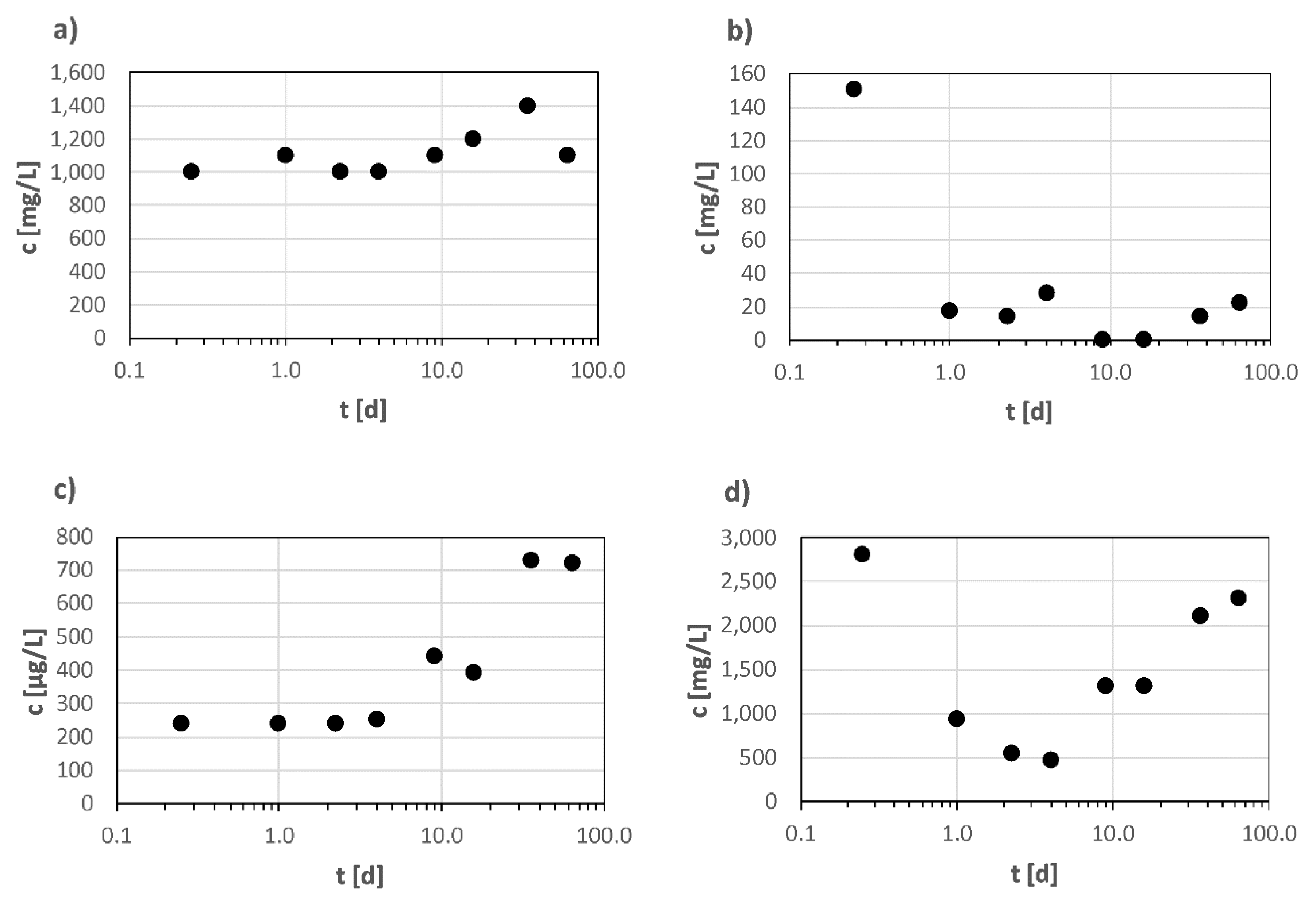
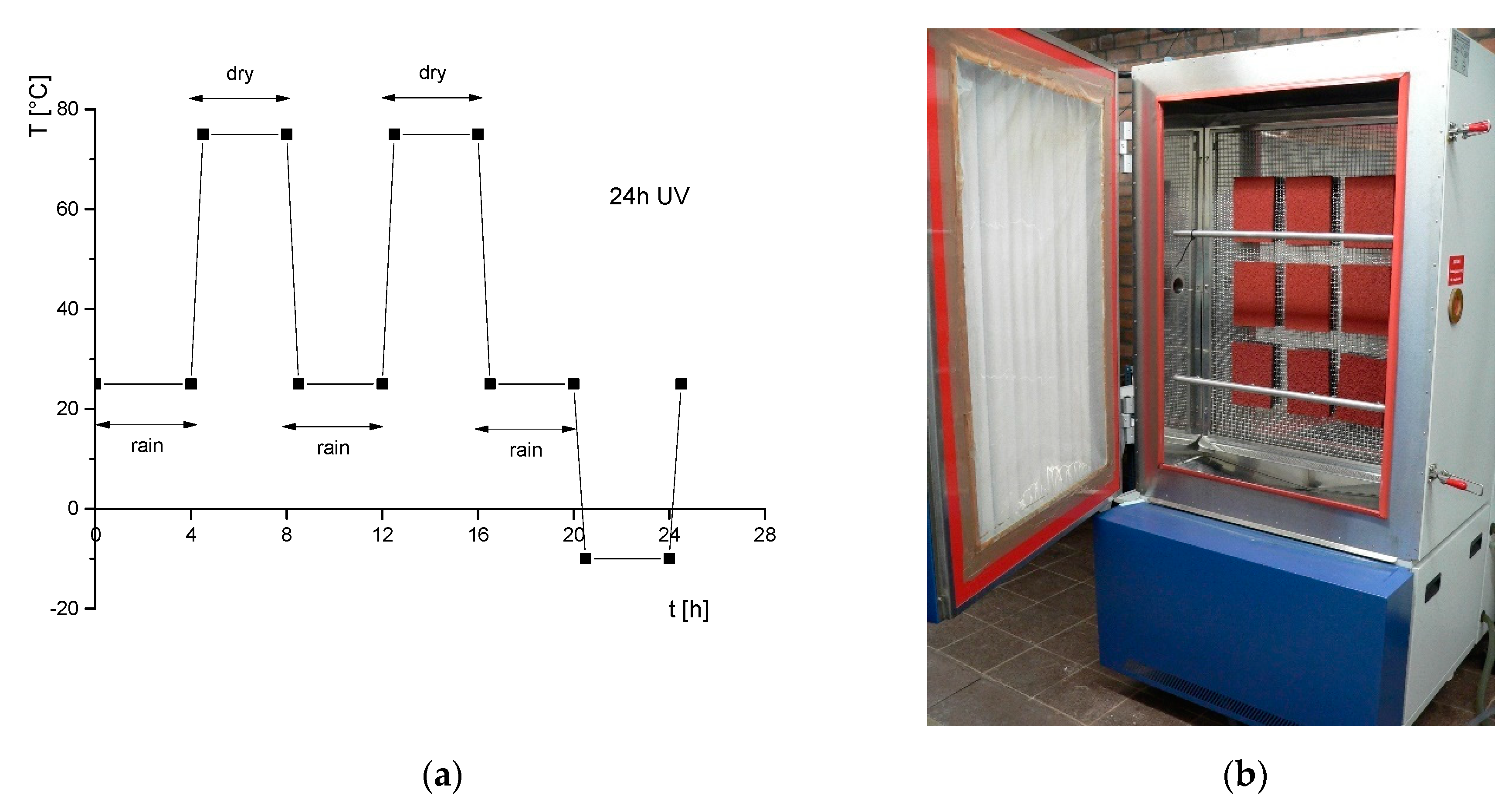

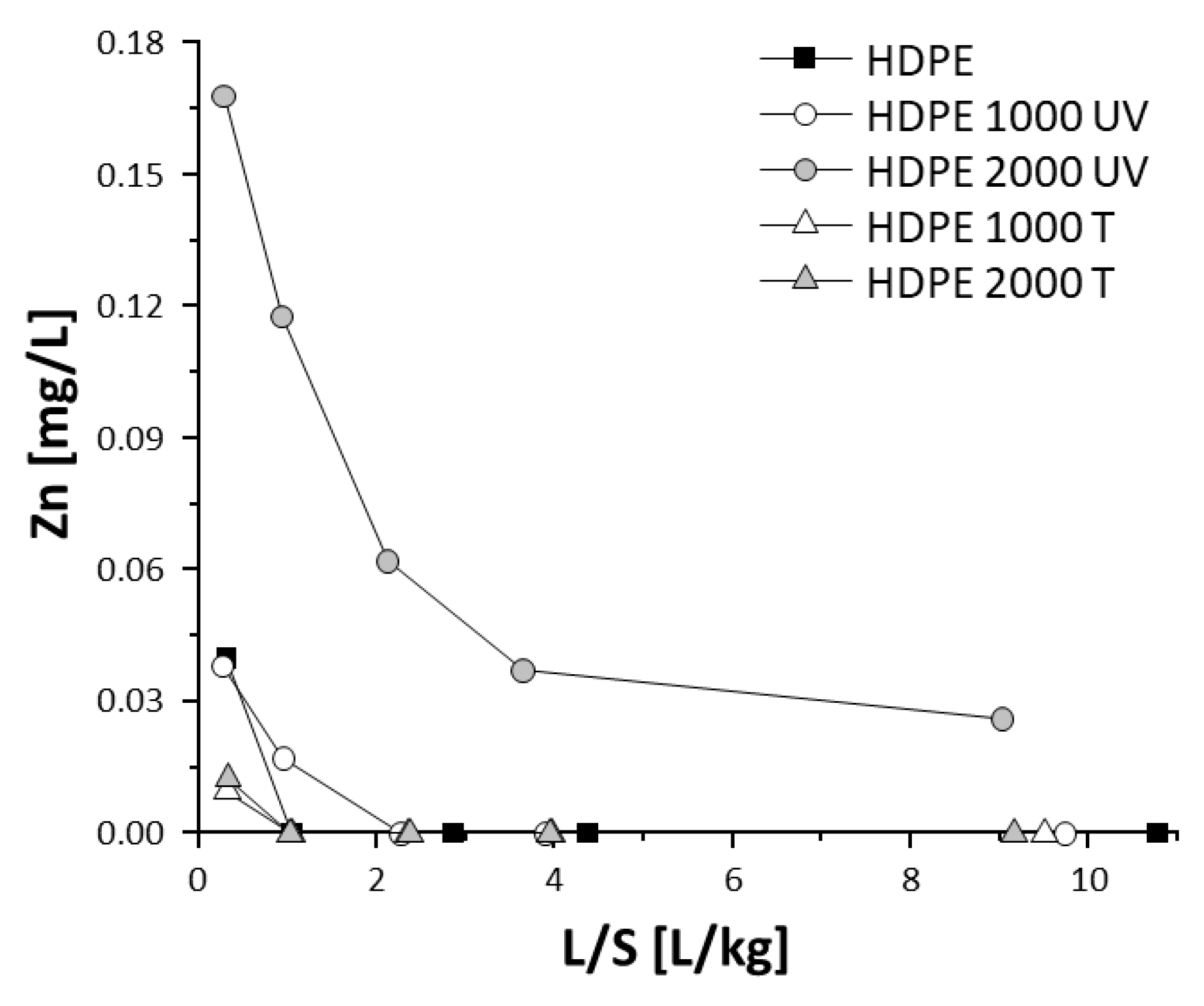


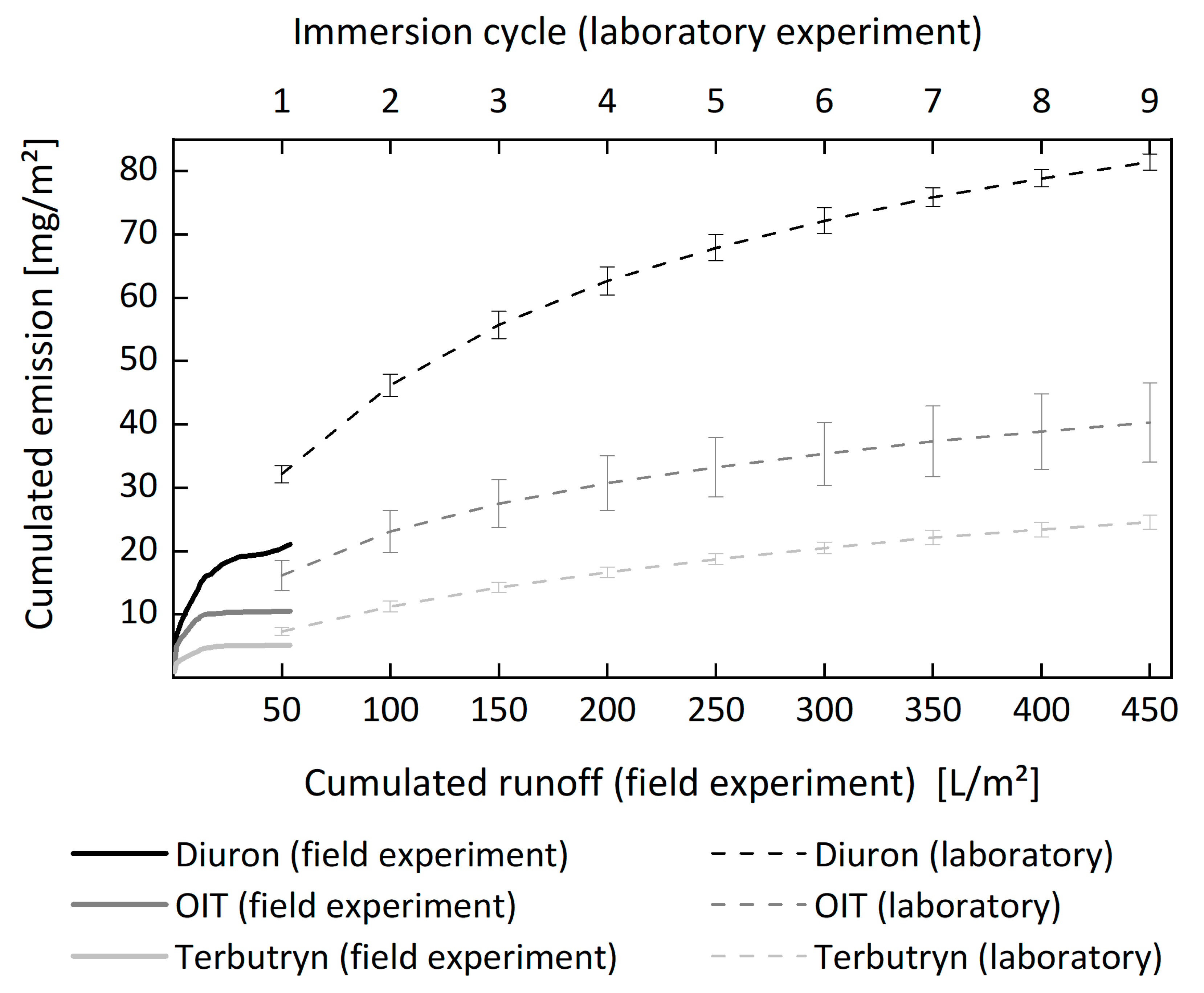
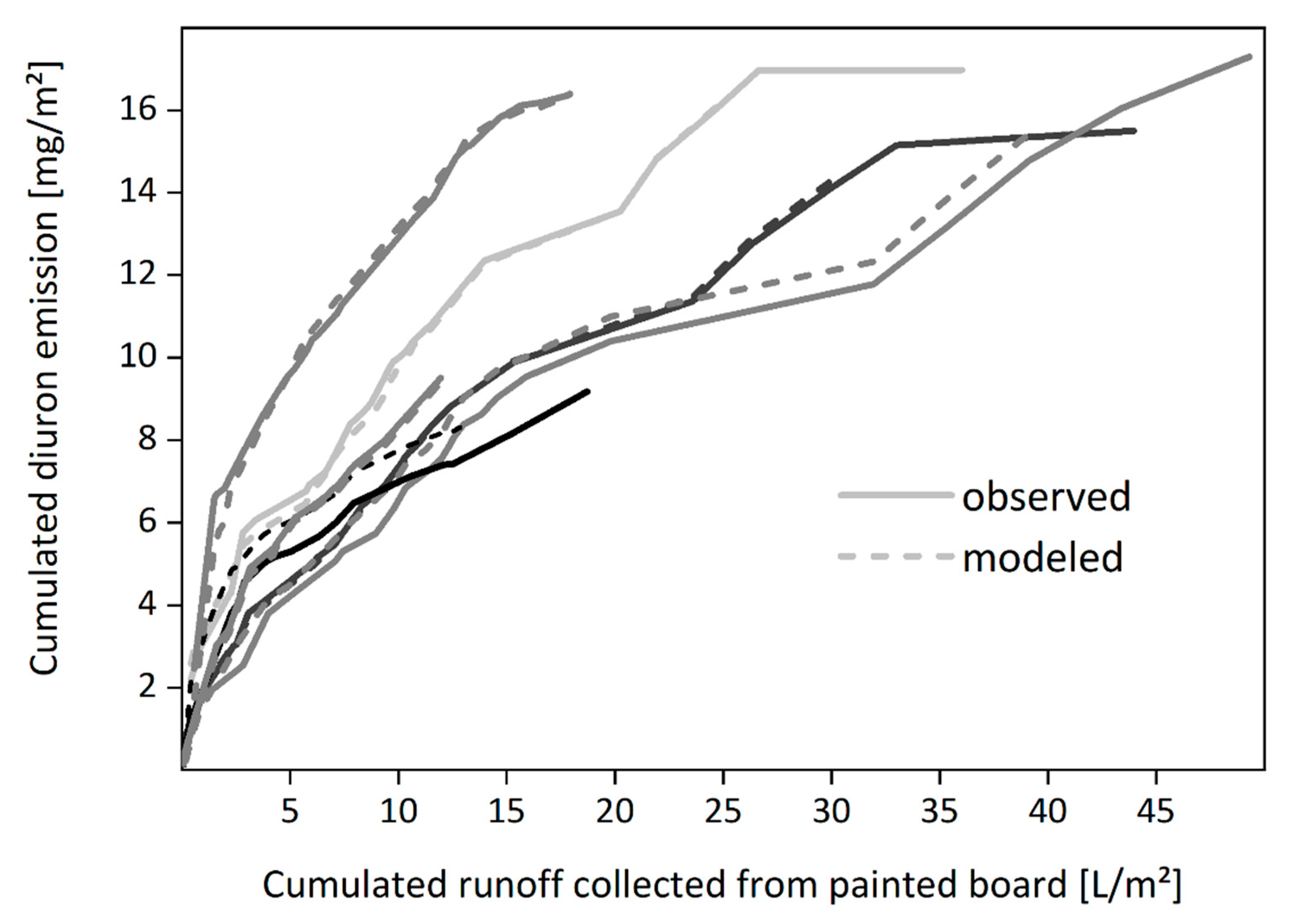
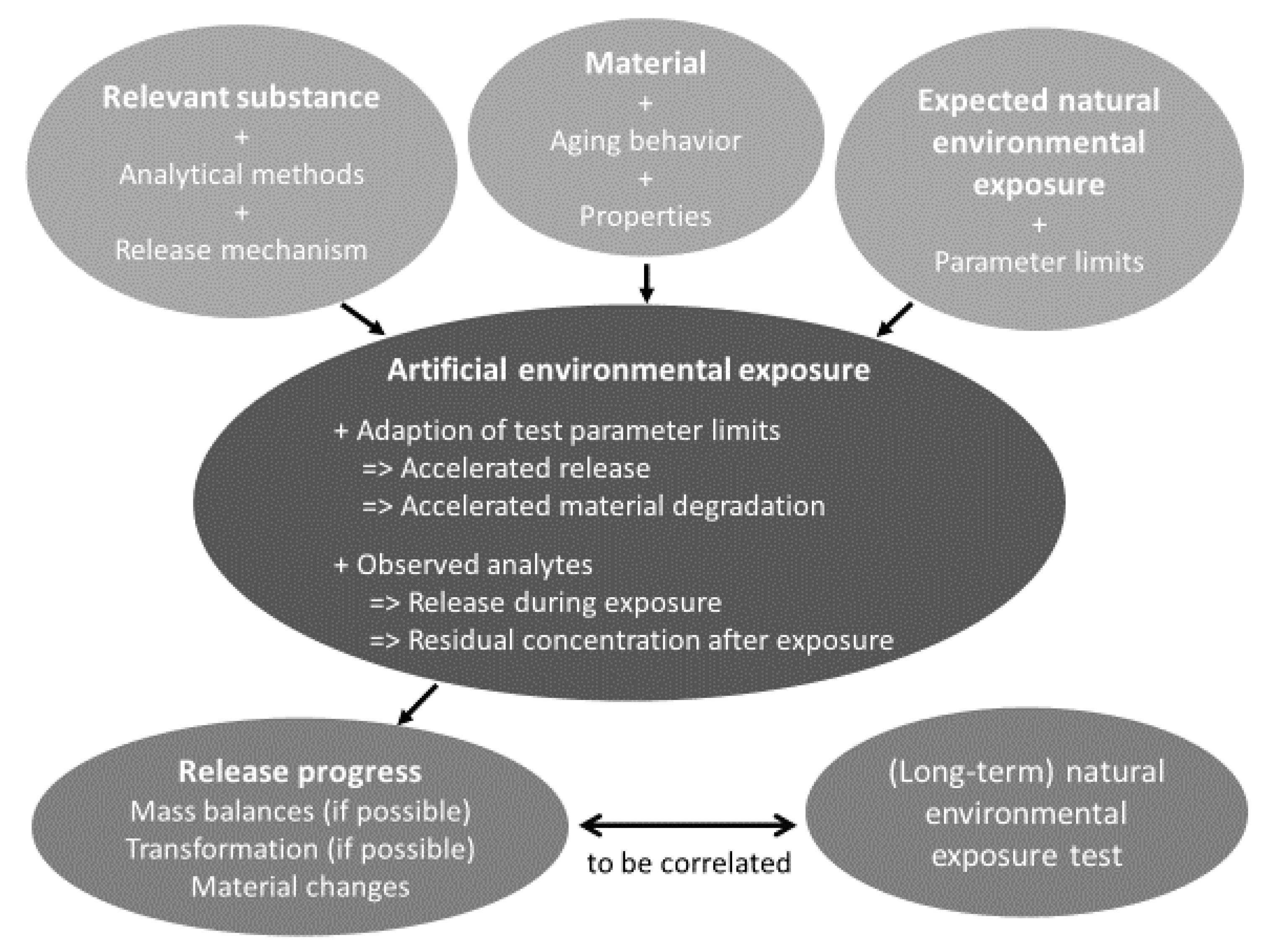
© 2020 by the authors. Licensee MDPI, Basel, Switzerland. This article is an open access article distributed under the terms and conditions of the Creative Commons Attribution (CC BY) license (http://creativecommons.org/licenses/by/4.0/).
Share and Cite
Bandow, N.; Aitken, M.D.; Geburtig, A.; Kalbe, U.; Piechotta, C.; Schoknecht, U.; Simon, F.-G.; Stephan, I. Using Environmental Simulations to Test the Release of Hazardous Substances from Polymer-Based Products: Are Realism and Pragmatism Mutually Exclusive Objectives? Materials 2020, 13, 2709. https://doi.org/10.3390/ma13122709
Bandow N, Aitken MD, Geburtig A, Kalbe U, Piechotta C, Schoknecht U, Simon F-G, Stephan I. Using Environmental Simulations to Test the Release of Hazardous Substances from Polymer-Based Products: Are Realism and Pragmatism Mutually Exclusive Objectives? Materials. 2020; 13(12):2709. https://doi.org/10.3390/ma13122709
Chicago/Turabian StyleBandow, Nicole, Michael D. Aitken, Anja Geburtig, Ute Kalbe, Christian Piechotta, Ute Schoknecht, Franz-Georg Simon, and Ina Stephan. 2020. "Using Environmental Simulations to Test the Release of Hazardous Substances from Polymer-Based Products: Are Realism and Pragmatism Mutually Exclusive Objectives?" Materials 13, no. 12: 2709. https://doi.org/10.3390/ma13122709
APA StyleBandow, N., Aitken, M. D., Geburtig, A., Kalbe, U., Piechotta, C., Schoknecht, U., Simon, F.-G., & Stephan, I. (2020). Using Environmental Simulations to Test the Release of Hazardous Substances from Polymer-Based Products: Are Realism and Pragmatism Mutually Exclusive Objectives? Materials, 13(12), 2709. https://doi.org/10.3390/ma13122709






